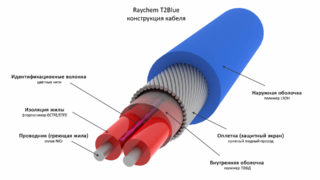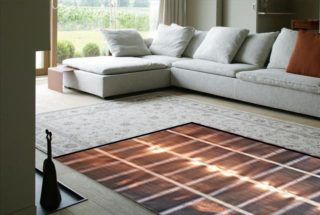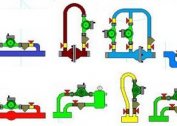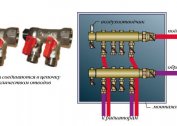The heat-insulated floor of mobile type belongs to modern heating systems of apartments and private houses. Its main feature is the ability to move the floor to any suitable place in the room. Mobile underfloor heating is presented in several versions, has its own technical characteristics, advantages and disadvantages. Before buying, it will be useful to study the features of such floors, as well as the available options from well-known manufacturers.
Options for mobile underfloor heating
The warm portable floor partially resembles the usual stationary counterpart, but it requires less maintenance and installation costs. For the mobile floor does not require the installation of flooring, laying a new waterproofing layer, as well as pouring screed. It is enough to spread it around the perimeter of the room, set the temperature at the desired level and connect it to the network. Depending on the type of heating element and heating method, such floors can be infrared or resistive.
Infrared
The infrared version is a film with a carbon mixture, which is applied to it in a continuous layer or in the form of separate tracks. Infrared radiation provides the electric current that is supplied to the heating element. Radiation waves with a length of 5-20 microns warm up not only the coating itself, but also the surrounding air masses. To ensure the correct direction of the rays, a foil substrate is located at the bottom of the floor.
Resistive
The resistive coating consists of metal tracks with a high level of resistance, to which two cables conducting electric current are connected in parallel to each other. Due to this scheme, the device operates even in the event of failure of individual heating elements.
The tracks are located at a distance of one millimeter from each other, due to this arrangement, the surface of the entire system is heated evenly. The resistive floor consists of a polymer base, metal tracks and a protective plastic layer. Mobile coatings easily withstand unwinding and twisting during operation.
Specifications
A mobile underfloor heating floor or carpet is a heating electric part that is in a flexible film with a high level of heat resistance. A product of this type is able to heat up to 55 degrees, this is the best indicator, safe for humans. The design of the mobile floor includes the following elements:
- the film, which is the basis of the device;
- heating elements;
- protective layer;
- cable for connecting to the mains;
- temperature regulator;
- Power Supply.
Heating in portable floor heating equipment occurs due to the access of electric current to the heating elements. The device can be used by placing it under the palace or rug, while the coating should completely cover the mobile system.
Manufacturers produce mobile floors for electricity networks with a voltage of 12 and 220 volts, the device power per square meter can vary between 200-600 watts.
Advantages and disadvantages
 A portable underfloor heating has many advantages that are noted by users who have installed such coverage in a house or apartment. This list includes:
A portable underfloor heating has many advantages that are noted by users who have installed such coverage in a house or apartment. This list includes:
- ease of use, no installation problems;
- the ability to heat any area in the room without the need for additional installation work;
- safety and environmental friendliness, lack of secretions that provoke allergies;
- accelerated and uniform heating of the surface;
- increased level of efficiency;
- acceptable heating temperature;
- low cost.
Mobile underfloor heating has practically no drawbacks. Of the main disadvantages, users note high operating costs, as well as compliance with strict safety rules in the process of using portable electrical equipment for heating flooring.
The film system is not laid under parquet, laminate or wood, since their hard layer significantly reduces the efficiency of the device’s workflow. When installing under linoleum, you need to consider that it can emit an unpleasant odor and harmful substances.
Installation Rules
Mobile warm coating does not require special installation, for its installation it is enough to deploy the mat and connect to the network. It is possible to lay the heating system on the floor with any finish, given how smooth the coating is. The heating of the air is carried out in the upward direction, for this reason the material of which the base is made will not matter. The upper part of the floors is covered with soft decorative coatings.
You can only install mats on an even footing; recesses and cracks can cause equipment failure. Furniture and any interior items are not placed on the finished coating, otherwise the device will overheat. It is necessary to connect the film equipment to the mains separately from other devices, while the system must have an integrated device with a fuse. Mobile mats are used only when unfolded, they can not be folded into several layers.
In order for the thermostat to work properly and for a long time, it can not be covered with carpets. It is allowed to cover only the film part of the device itself.
Well-known manufacturers of mobile underfloor heating
 A large number of mobile floor heating manufacturers are represented on the market. Among them, users distinguish three brands that have proven themselves on the positive side.
A large number of mobile floor heating manufacturers are represented on the market. Among them, users distinguish three brands that have proven themselves on the positive side.
Express
Floors Heatlux Express work on the principle of heating mats. They need to be covered with a hermetic material, which resembles rubber in properties, and lay a cable up to 2.5 meters long. The top is supplemented with artificial felt, which does not require special care. The advantages of such floors include the possibility of mounting on any surface, including linoleum, laminate, tile or parquet, full compliance with all safety standards and resistance to flame. Mobile brand coverings can be used both indoors and on balconies or loggias.
Synplen
Portable floor mats Sinplen express are in great demand among buyers. These are thin coatings with a thickness of 0.6 mm. They are recommended to be combined with carpet and laminate. The brand’s mobile floors will function even after the failure of one or more elements. They are supplemented with a special temperature controller to maintain it at the optimum level and can also be used to heat balconies and loggias.
Trio
Coatings from the Trio brand have a thickness of 0.6 mm. They are recommended to be used mainly for spot heating, for example, in the area of the room where the residents are most often located. Among the advantages of floors of this type, low energy consumption combined with low cost are noted.






